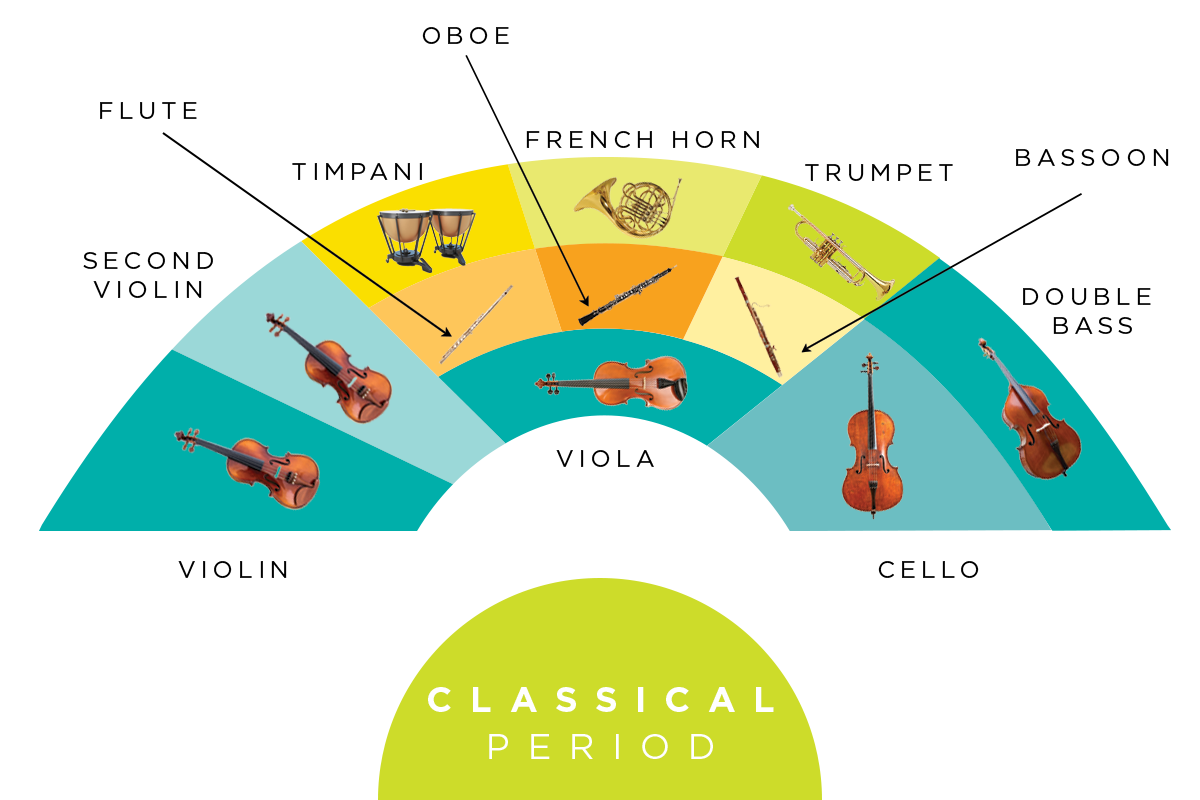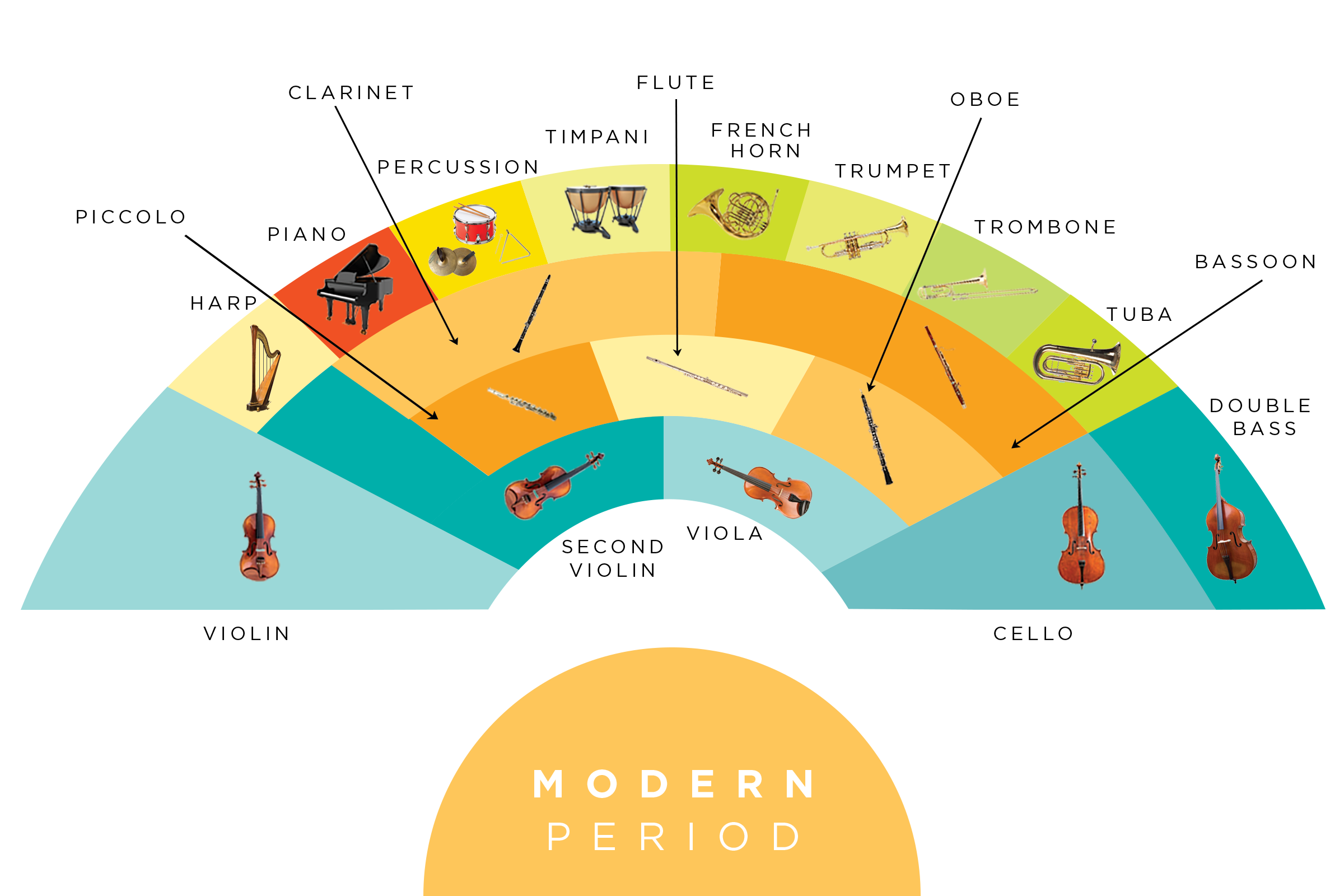Adventures with Beethoven
Scene Four
History of the Orchestra
Musicians have always played together. Whether it was a few friends playing together at a pub or a party or a more formalized group for a church setting or at court, music is meant to be shared with others.
Originally ensembles were formed with whatever instruments were available. Music written in the Medieval and Renaissance periods often did not specify which instruments the composer had in mind. If a group had harps, lutes, viols (an early bowed string instrument), and recorders they would adapt the parts to fit the instruments they had available. Eventually these groups of musicians became called a consort. Consort was also used to describe the music the group played and their performance. Sometimes groups were called whole consorts or broken consorts. A whole consort referred to a group that features instruments of only one type, only strings or only winds, for example. A broken consort contained more than one type of instrument.
Medieval instruments, from Box-Elder.blogspot.com
As the Renaissance progressed, composers started writing more complicated music. One of these larger, more complicated compositions was the opera Orfeo, written by Claudio Monteverdi in 1607. Monteverdi carefully indicated exactly which instruments he wanted to accompany the opera, including fifteen viols, two violins, four flutes, two oboes, two cornetts (a type of wooden trumpet), four trumpets, five trombones, a harp, two harpsichords, and three organs. This ensemble looks quite a bit like what we see on a concert stage today; the instruments were grouped together into sections, there were lots of string players, and a variety of other instruments to provide different sounds.
Over the next 200 years, instruments, especially the woodwinds and brass, became more advanced. By adding more keys and using new materials, the instrumentalists were able to play more complex music. As the instruments were able to play more notes, keyboard instruments, such as harpsichord, became less important and gradually fell into disuse. Other composers followed Monteverdi’s lead and wrote their pieces with specific instruments in mind, allowing new colors to shine in the group.
From Dallas Symphony
Early orchestras rarely had a conductor. Usually, the job of keeping the tempo and the musicians together fell to either the keyboard player or one of the string players. When harpsichords or organs were commonly part of the orchestra, the instrument was often placed in the center of the ensemble and the keyboardist would lead the group. Eventually this job fell to the first chair violin player, who became known as the concertmaster (a title still held by the first chair violin in orchestras today). However, as orchestras continued to increase in size, not everyone could see the concertmaster well enough to see the tempo. Also, as music became more complicated it was hard for the concertmaster to play and lead the group. Soon, one person, who wasn’t playing an instrument, became the leader. The conductor would lead the group, setting the tempo, and making sure all the musicians are together. Conductors began using a baton to help the musicians see the tempo and cues. Often in the 1800s composers would conduct their own pieces. Now some musicians specialize in conducting and have that as their primary job with the orchestra.
From Dallas Symphony
In the late 1800s and into the 1900s orchestras continued to grow. Composers like Richard Wagner, Gustav Mahler, and Richard Strauss wrote symphonies and other orchestral works for incredibly large groups of musicians. While still utilizing the main sections of the orchestra, these composers often wrote for large string sections and added extra instruments in the woodwind, brass, and percussion sections.
From Dallas Symphony
Over the last 100 years, composers have written for orchestras of various sizes, from small chamber ensembles to a basic 19th century orchestra that Beethoven would have recognized, to huge groups with hundreds of musicians on stage. Each group provides a different experience for the listener. Conductors have become more famous as well, with some, such as Leopold Stokowski and Leonard Bernstein becoming household names. Conductors became the face of the orchestra and influenced listening habits by what pieces they had their orchestras perform. When you attend an orchestra concert today, you are listening to a group that audiences have enjoyed for hundreds of years. Although the music and instruments have changed since the 1600s, there is something magical when a group of people come together to create a musical moment.
From Dallas Symphony




